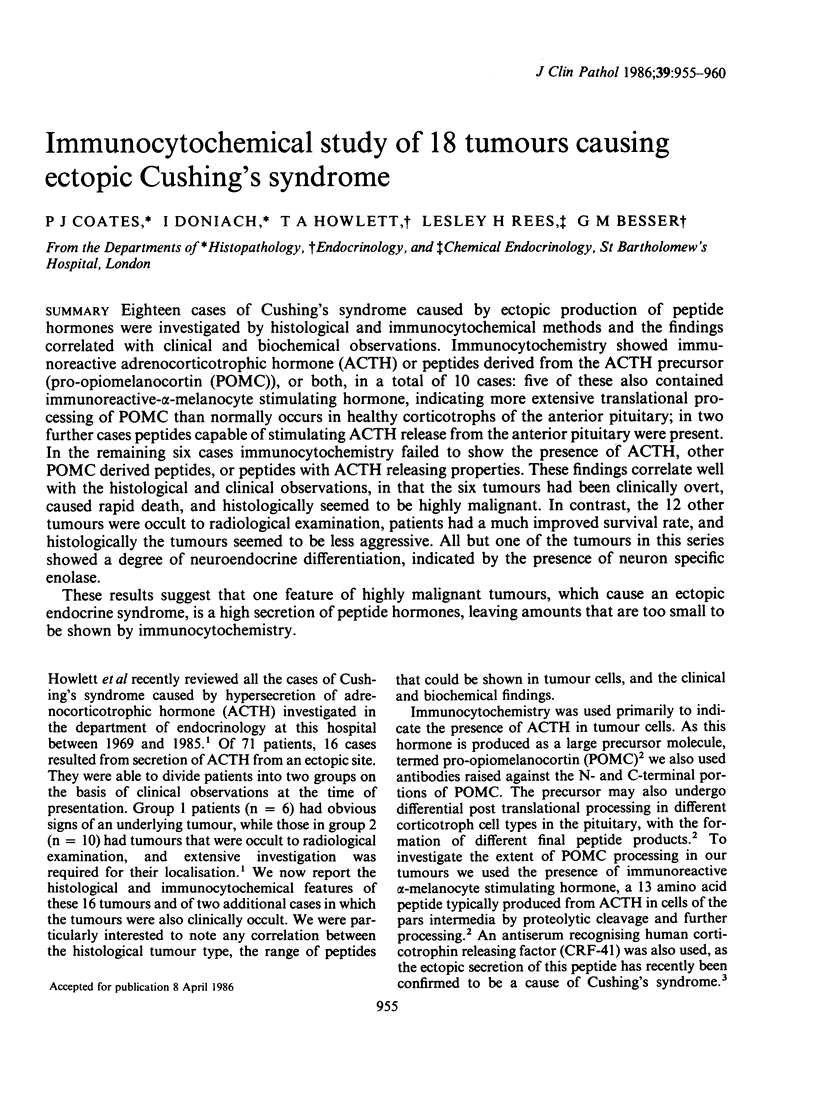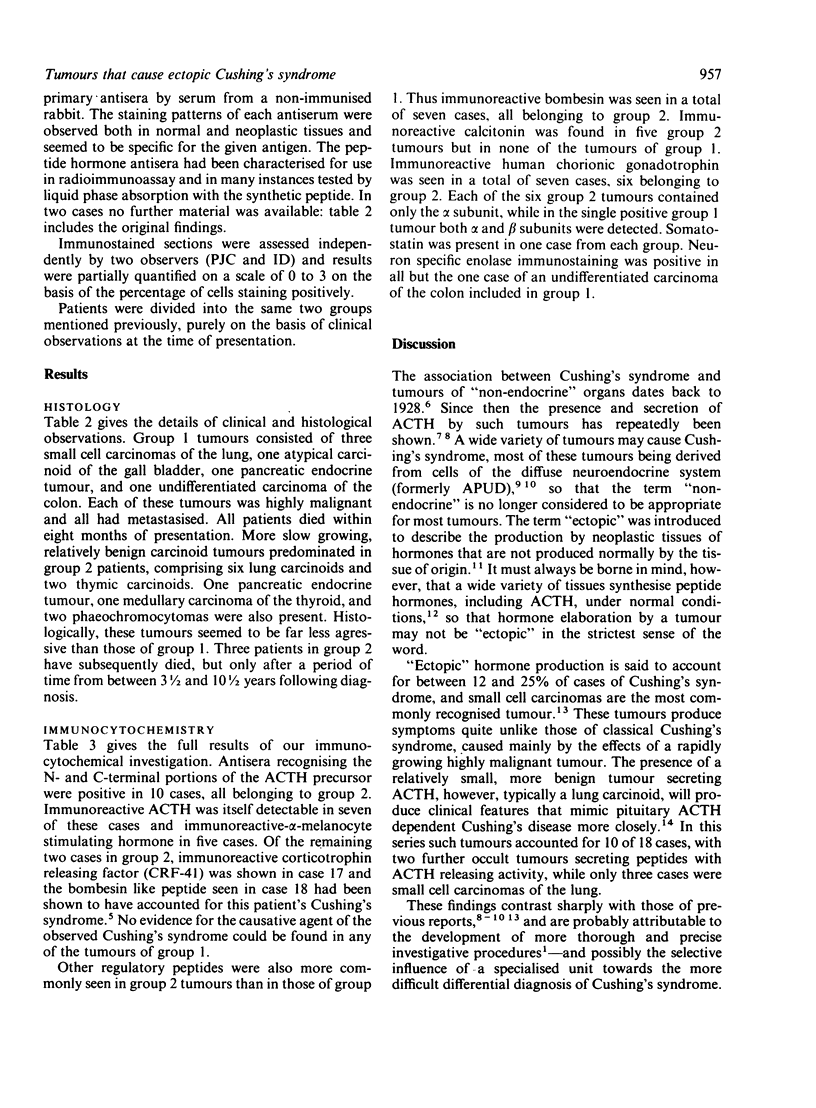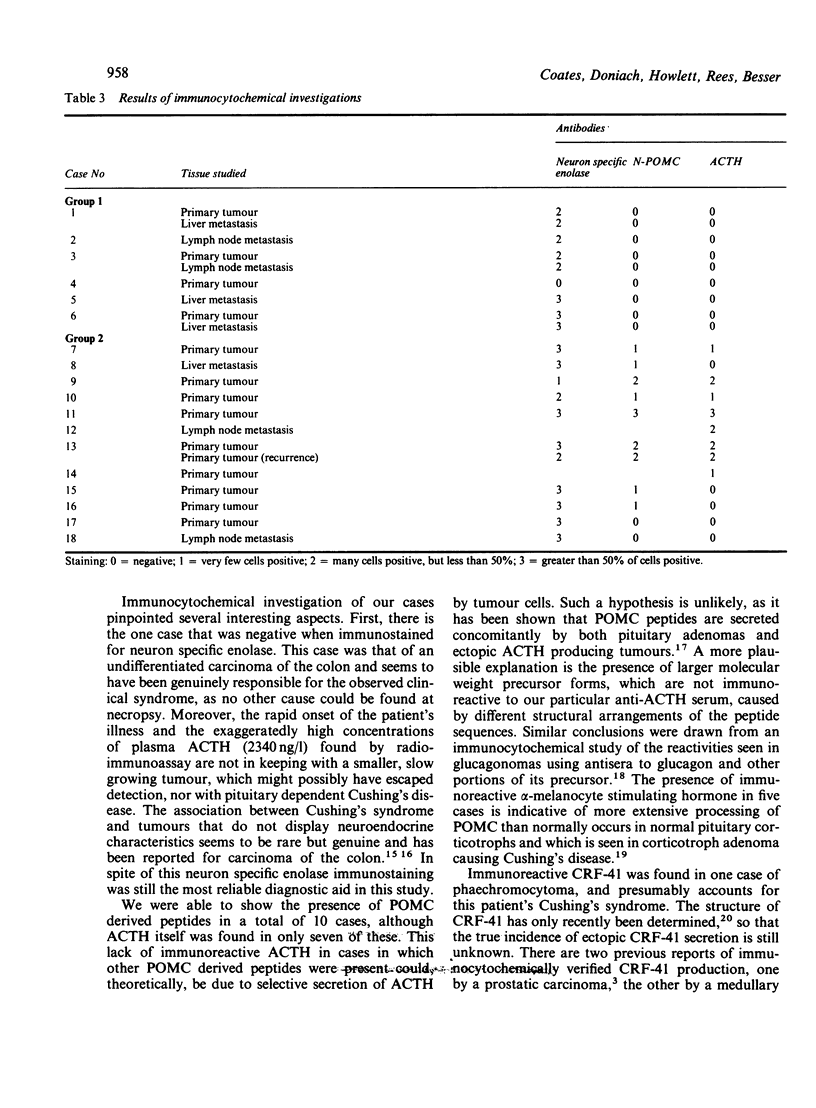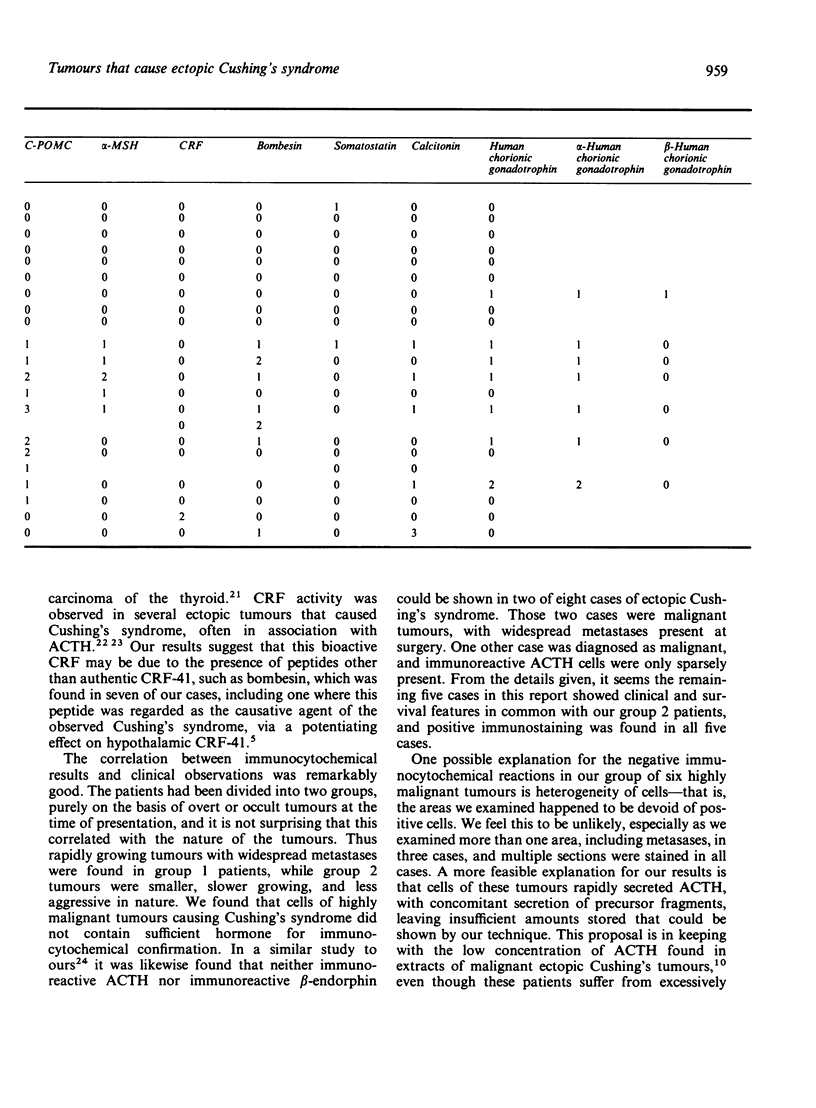Abstract
Eighteen cases of Cushing's syndrome caused by ectopic production of peptide hormones were investigated by histological and immunocytochemical methods and the findings correlated with clinical and biochemical observations. Immunocytochemistry showed immunoreactive adrenocorticotrophic hormone (ACTH) or peptides derived from the ACTH precursor (pro-opiomelanocortin (POMC], or both, in a total of 10 cases: five of these also contained immunoreactive-alpha-melanocyte stimulating hormone, indicating more extensive translational processing of POMC than normally occurs in healthy corticotrophs of the anterior pituitary; in two further cases peptides capable of stimulating ACTH release from the anterior pituitary were present. In the remaining six cases immunocytochemistry failed to show the presence of ACTH, other POMC derived peptides, or peptides with ACTH releasing properties. These findings correlate well with the histological and clinical observations, in that the six tumours had been clinically overt, caused rapid death, and histologically seemed to be highly malignant. In contrast, the 12 other tumours were occult to radiological examination, patients had a much improved survival rate, and histologically the tumours seemed to be less aggressive. All but one of the tumours in this series showed a degree of neuroendocrine differentiation, indicated by the presence of neuron specific enolase. These results suggest that one feature of highly malignant tumours, which cause an ectopic endocrine syndrome, is a high secretion of peptide hormones, leaving amounts that are too small to be shown by immunocytochemistry.
Full text
PDF





Selected References
These references are in PubMed. This may not be the complete list of references from this article.
- Azzopardi J. G., Williams E. D. Pathology of 'nonendocrine' tumors associated with Cushing's syndrome. Cancer. 1968 Aug;22(2):274–286. doi: 10.1002/1097-0142(196808)22:2<274::aid-cncr2820220204>3.0.co;2-w. [DOI] [PubMed] [Google Scholar]
- Balsam A., Bernstein G., Goldman J., Sachs B. A., Rifkin H. Ectopic adrenocorticotropin syndrome associated with carcinoma of the colon. Gastroenterology. 1972 Apr;62(4):636–641. [PubMed] [Google Scholar]
- Belsky J. L., Cuello B., Swanson L. W., Simmons D. M., Jarrett R. M., Braza F. Cushing's syndrome due to ectopic production of corticotropin-releasing factor. J Clin Endocrinol Metab. 1985 Mar;60(3):496–500. doi: 10.1210/jcem-60-3-496. [DOI] [PubMed] [Google Scholar]
- CHRISTY N. P. Adrenocorticotrophic activity in the plasma of patients with Cushing's syndrome associated with pulmonary neoplasms. Lancet. 1961 Jan 14;1(7168):85–86. doi: 10.1016/s0140-6736(61)92125-0. [DOI] [PubMed] [Google Scholar]
- Carey R. M., Varma S. K., Drake C. R., Jr, Thorner M. O., Kovacs K., Rivier J., Vale W. Ectopic secretion of corticotropin-releasing factor as a cause of Cushing's syndrome. A clinical, morphologic, and biochemical study. N Engl J Med. 1984 Jul 5;311(1):13–20. doi: 10.1056/NEJM198407053110103. [DOI] [PubMed] [Google Scholar]
- Eipper B. A., Mains R. E. Structure and biosynthesis of pro-adrenocorticotropin/endorphin and related peptides. Endocr Rev. 1980 Winter;1(1):1–27. doi: 10.1210/edrv-1-1-1. [DOI] [PubMed] [Google Scholar]
- Hamid Q. A., Bishop A. E., Sikri K. L., Varndell I. M., Bloom S. R., Polak J. M. Immunocytochemical characterization of 10 pancreatic tumours, associated with the glucagonoma syndrome, using antibodies to separate regions of the pro-glucagon molecule and other neuroendocrine markers. Histopathology. 1986 Feb;10(2):119–133. doi: 10.1111/j.1365-2559.1986.tb02468.x. [DOI] [PubMed] [Google Scholar]
- Heitz P. U., Klöppel G., Polak J. M., Staub J. J. Ectopic hormone production by endocrine tumors: localization of hormones at the cellular level by immunocytochemistry. Cancer. 1981 Nov 1;48(9):2029–2037. doi: 10.1002/1097-0142(19811101)48:9<2029::aid-cncr2820480920>3.0.co;2-n. [DOI] [PubMed] [Google Scholar]
- Howlett T. A., Drury P. L., Perry L., Doniach I., Rees L. H., Besser G. M. Diagnosis and management of ACTH-dependent Cushing's syndrome: comparison of the features in ectopic and pituitary ACTH production. Clin Endocrinol (Oxf) 1986 Jun;24(6):699–713. doi: 10.1111/j.1365-2265.1986.tb01667.x. [DOI] [PubMed] [Google Scholar]
- Howlett T. A., Price J., Hale A. C., Doniach I., Rees L. H., Wass J. A., Besser G. M. Pituitary ACTH dependent Cushing's syndrome due to ectopic production of a bombesin-like peptide by a medullary carcinoma of the thyroid. Clin Endocrinol (Oxf) 1985 Jan;22(1):91–101. doi: 10.1111/j.1365-2265.1985.tb01069.x. [DOI] [PubMed] [Google Scholar]
- Liddle G. W., Nicholson W. E., Island D. P., Orth D. N., Abe K., Lowder S. C. Clinical and laboratory studies of ectopic humoral syndromes. Recent Prog Horm Res. 1969;25:283–314. doi: 10.1016/b978-0-12-571125-8.50009-0. [DOI] [PubMed] [Google Scholar]
- MEADOR C. K., LIDDLE G. W., ISLAND D. P., NICHOLSON W. E., LUCAS C. P., NUCKTON J. G., LUETSCHER J. A. Cause of Cushing's syndrome in patients with tumors arising from "nonendocrine" tissue. J Clin Endocrinol Metab. 1962 Jul;22:693–703. doi: 10.1210/jcem-22-7-693. [DOI] [PubMed] [Google Scholar]
- Martin R., Cetin Y., Fehm H. L., Fahlbusch R., Voigt K. H. Multiple cellular forms of corticotrophs in surgically removed pituitary adenomas and periadenomatous tissue in Cushing's disease. Am J Pathol. 1982 Mar;106(3):332–341. [PMC free article] [PubMed] [Google Scholar]
- Mason A. M., Ratcliffe J. G., Buckle R. M., Mason A. S. ACTH secretion by bronchial carcinoid tumours. Clin Endocrinol (Oxf) 1972 Jan;1(1):3–25. doi: 10.1111/j.1365-2265.1972.tb00374.x. [DOI] [PubMed] [Google Scholar]
- Miura K., Demura H., Sato E., Sasano N., Shimizu N. A case of ACTH-secreting cancer of the colon. J Clin Endocrinol Metab. 1970 Nov;31(5):591–595. doi: 10.1210/jcem-31-5-591. [DOI] [PubMed] [Google Scholar]
- Neville A. M. Ectopic production of hormones by tumours. Pathological aspects of the para-endocrine syndrome. Proc R Soc Med. 1972 Jan;65(1):55–59. [PMC free article] [PubMed] [Google Scholar]
- Ratter S. J., Gillies G., Hope J., Hale A. C., Grossman A., Gaillard R., Cook D., Edwards C. R., Rees L. H. Pro-opiocortin related peptides in human pituitary and ectopic ACTH secreting tumours. Clin Endocrinol (Oxf) 1983 Mar;18(3):211–218. doi: 10.1111/j.1365-2265.1983.tb03205.x. [DOI] [PubMed] [Google Scholar]
- Rees L. H., Ratcliffe J. G. Ectopic hormone production by non-endocrine tumours. Clin Endocrinol (Oxf) 1974 Jul;3(3):263–299. doi: 10.1111/j.1365-2265.1974.tb01801.x. [DOI] [PubMed] [Google Scholar]
- Saito E., Odell W. D. Corticotropin/lipotropin common precursor-like material in normal rat extrapituitary tissues. Proc Natl Acad Sci U S A. 1983 Jun;80(12):3792–3796. doi: 10.1073/pnas.80.12.3792. [DOI] [PMC free article] [PubMed] [Google Scholar]
- Tapia F. J., Polak J. M., Barbosa A. J., Bloom S. R., Marangos P. J., Dermody C., Pearse A. G. Neuron-specific enolase is produced by neuroendocrine tumours. Lancet. 1981 Apr 11;1(8224):808–811. doi: 10.1016/s0140-6736(81)92682-9. [DOI] [PubMed] [Google Scholar]
- Upton G. V., Amatruda T. T., Jr Evidence for the presence of tumor peptides with corticotropin-releasing-factor-like activity in the ectopic ACTH syndrome. N Engl J Med. 1971 Aug 19;285(8):419–424. doi: 10.1056/NEJM197108192850801. [DOI] [PubMed] [Google Scholar]
- Vale W., Spiess J., Rivier C., Rivier J. Characterization of a 41-residue ovine hypothalamic peptide that stimulates secretion of corticotropin and beta-endorphin. Science. 1981 Sep 18;213(4514):1394–1397. doi: 10.1126/science.6267699. [DOI] [PubMed] [Google Scholar]
- Yamamoto H., Hirata Y., Matsukura S., Imura H., Nakamura M., Tanaka A. Studies on ectopic ACTH-producing tumours. IV. CRF-like activity in tumour tissue. Acta Endocrinol (Copenh) 1976 May;82(1):183–192. [PubMed] [Google Scholar]


